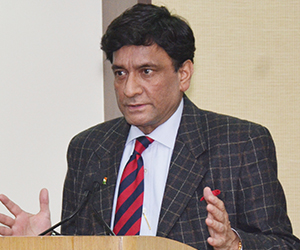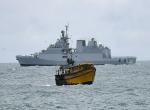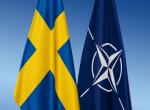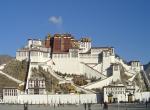The thirteenth Indo-Russian Summit was a fleeting affair, with President Putin spending less than twenty-four hours in Delhi. It came as the stakes in the extended neighbourhood are growing higher – Afghanistan, Iran, and the broader West Asian region are all in a state of flux that has serious implications for both India and Russia. Similar stakes are in play in the East, and once more, as India seeks to step up its engagement in the Asia-Pacific Region, there are implications for our interface with Russia here too.
The bilaterals are reasonably well-known, and there are serious attempts ongoing at all levels to find ways to deepen the engagement, and to find solutions to issues that have dominated the discourse over the past few years – the Vikramaditya, the nuclear liability, the low levels of trade and investment, etc. So, too, are the benefits of the cooperation, whether it is INS Chakra, or Brahmos, or diplomatic support on key issues like permanent membership of the UN Security Council, which we take for granted from a country like Russia.
There are also problematic issues that need to be addressed, and were discussed in some detail. Apart from the issues of our defence cooperation, there were the nuclear liability question, and that of the 2G license for the Sistema-majority owned SSTL. On these, there is nothing in the public domain, but the Russian press commentaries have suggested that the nuclear liability issue could be resolved by raising the cost of the projects, thus building in some element of protection in the event that the supplier has to pay compensation. On the Sistema issue, there does not seem to have been much progress.
Where there was welcome progress, it was on the purchase of LNG from Russia. This is an issue that has long been discussed, including at the highest levels. However, while there had been no progress so far, we seem to have made the breakthrough. Of course, there is a better way to take this forward to higher levels: this would involve a four-way swap arrangement, involving the Persian Gulf suppliers, and their buyers in East Asia [South Korea, Japan], India and Russia. The swap arrangement would involve the Gulf suppliers diverting their supplies to East Asia to India; in return, Russia would make good the diverted deliveries and supply to East Asia. All four parties would gain from reduced transportation costs, and that would be welcome in these times, when all major economies are facing difficult challenges.
Another noteworthy outcome of the visit was the reference to the discussions between India and the Eurasian Economic Commission on a possible Comprehensive Economic Cooperation Agreement. There has been one such study done between India and Russia in 2007, but that was never seriously pursued. Now that Russia has formed the Customs Union with Belarus and Kazakhstan, it is a good time to launch another such examination. Hopefully, this can provide answers to the current slow growth of economic relations between India and Russia.
However, there is insufficient attention being paid to the regional issues that affect both India and Russia, and on which there is not enough dialogue at the official level, and which do not get sufficient attention among commentators. And it is important to understand these issues from the Russian perspective. That way, we shall not face any surprises in what our friends in Moscow do, and they, in turn, will understand how we in New Delhi are looking at things and deciding on policy choices.
Without doubt, the most important is Afghanistan and the impending pull-out/thinning out of the ISAF in 2014. From our perspective, things do not look very reassuring: recent reports of the activities of the High Peace Council suggest that a serious effort is in hand to pave the way for the Taliban to return to at least some share in power in Kabul, with Pakistan being accepted as the major arbiter. The accepted view is that the US is agreeable to such a dispensation, as is NATO. China, of course, will back Pakistan. Alone among the major powers, then, Russia could be expected to show some understanding of the Indian fears over such a plan.
Regrettably, we are not seeing enough engagement between India and Russia on this issue, even though both countries share similar approaches. Indeed, we had collaborated in the 1990’s – a time when Russia under Yeltsin had not fully recovered from the trauma of the destruction of the USSR – in order to blunt the Taliban offensive inside Afghanistan. Today, what we are seeing is Pakistani service chiefs visiting Russia, the DG ISI in Moscow, and the Pakistan President offering Russia access to the warm waters on his own visit. There is a real risk of our being isolated, all the more so because we are also seeking to put distance between ourselves and Iran – the other country that might be expected to share our concerns over the plans for post-2014 Afghanistan. This remains true, notwithstanding the high-level bilateral contacts we have maintained with Iran over the years.
The second issue of concern flows from the Iran situation, and the related one of Syria’s future. During the Putin visit, the two sides found agreement on Iran’s right to peaceful uses of, and research in, nuclear energy, while calling for all issues to be settled by peaceful means only. On Syria, too, there is common ground in terms of the UN Resolutions and a call to all sides to seek a peaceful settlement. But, of course, there will be no peaceful settlement that is the one thing all sides are agreed upon. But, more important, shorn of this kind of fudge, there are clear differences between India and Russia on how to approach both Iran and Syria. It is instructive to compare what we have said in the current Joint Statement, and what the Russians said with the Chinese when Putin visited Beijing in June 2012. The Russian-Chinese statement contained a more forthright expression of support for Syrian independence and territorial integrity; it also spoke bluntly against foreign interference and said that the two countries were “resolutely opposed the attempt to resolve the Syrian crisis by way of foreign armed intervention and imposition of ‘regime change’. This would suggest that the Russian position on Syria did not get the full endorsement from India that it got from the Chinese.
The last substantive issue relating to the immediate neighbourhood is that of the so-called New Silk Road strategy for South and Central Asia. The Russians have their own approach to the region, and they are themselves keen to develop ties between the two regions. They call it CASA, and are keen to begin by selling surplus electricity from Tajikistan to Pakistan. They have a quadrilateral of their own – themselves, Afghanistan, Pakistan and Tajikistan – which has been pushing this project for several years now. It was under this rubric that President Putin was to visit Pakistan earlier in October last year. These transport and other linkages have been much in contention ever since the break-up of the Soviet Union, and are invested with heavy geo-strategic significance. Both India and Russia will need to tread carefully, and be willing to engage each other in an open and honest dialogue to remove any potential for misunderstanding in any of these projects.
There is also the emerging situation in the Asia-Pacific Region. America and some of the other key members in the region have been promoting the idea of a Concert of Democracies to stabilise future developments in the area. Much of this is driven by concerns over how China will evolve as it grows both economically and militarily. Here, Russia is not considered a major actor by any of the other leading actors; neither is it a potential partner, nor is it seen as being in the Chinese camp. However, India is very much in the reckoning of almost all the drivers of such a policy.
However, we need to recognise that Russia sees China – at least in the short term – as an important partner in the difficulties it is facing with the West in general and America in particular. It will therefore not be sympathetic to any combined effort that will have China as its objective. Equally, if it has serious frictions with any country in the region, it is Japan; and Japan is obviously an essential component of any strategy involving the democracies of the region.
All of this argues for an open and candid dialogue with Russia, so that each side understands the other’s concerns, and red lines. This has not been happening so far, and the truth is that where we are willing for a substantive conversation, they are not; China is an example. On the contrary, where they seek a frank dialogue, we tend to hold back; Afghanistan is an illustration. And yet, it is the interests of both sides to keep up a regular conversation. Both India and Russia face the problem of isolation; we have a tradition of friendship and trust that few other major powers have, and it needs to be maintained and nurtured.
Published Date: 14th January 2013










Post new comment